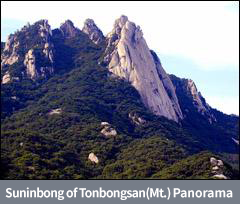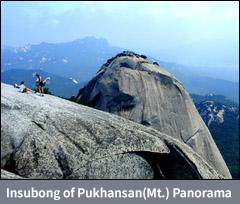CAC CONTENTS
-

-
CAC Contents
-
Seoul Big Slab by Rick Ruffin
- Outline
- Mountaineering around the capital
- Mt. Sorak with fascinating sights
- A great volcaic upheaval
- Scaling of high mountains aborad
- Overseas expeditions by CAC & KAF
- Vigorous climbing movement in Korea
- New Start
- Korean Rock by Rick Ruffin
- Seoul Big Slab by Rick Ruffin
- Winter Trill in Korea by Cho sung dae
Seoul Big Slab by Rick Ruffin
Seoul’s Big slab
-

-
Imagine a huge skillet. now imagine a series of huge globes of granite. Well, that is Pukhansan national Park. These granite globs offer everything the contem porary rock climber could possibly want. Few rock-climbing areas have such a variety of climbs, in such concentration. the rock has the consistencey of industrial sandpaper.
If you are keen on wedging your body between two parallel pillars of rough,white granite, and doing a series of squats,upward,ever upward,a series of grunts and groans that would make Arnold proud and leave your "quads"shaking, then the place for you.
If you fancy tripsing out over thin air, across a big, orange, moon-face of a rock, pinching a narrow ridge of rough cut crystals that leave your fingers feeling as if they`ve been hooked up to a car battery all morning, then you`ve found .
yoyr paradise.
If you know absolutely nothing about climbing, but want to learn a great sport and excellent excuse for exercise and fresh air, then Pukhansan is the place for you.
These are two major lumps of granite, and endless ridges of sun-drenched rock, scattered like pearls across the surface of of this 80 square kilometer park.
These geologic formations seem to have been cast down by the gods with climbing specifically in mind.
Insubong("bong" means peak in korean) and Soninbong are two major lumps of granite. Cho Sung-dae of the Corean Alpine club says Insubong boasts 40 classic rock-climbing routes while Soninbong features 30 great for climbing. Neither place is more than a one-hour bus ride from downtown.
Insubong is the primary climbing manager in Pukhasan National Park, a huge, bulging,orange dome of rock with 360 degrees of exposure(most of the climbing takes place on the west, south and east aspects). soaring nearly 1,000 feet above its surroundings.
It also sports a great low-angle apron, perfect for beginners, known simply as the Big Slab. Soninbong has no casy terrain.
Heavy traffic
The bad news is that the climbing in Korea is ridiculously crowded.
"We were 30 meters off the deck and marveling how lucky we were to have no one in front of us when about 10 climbers materialized from out of the wood at the bottom of the cliff like bounced checks," wrote one climbing historian in his journal. "They were rigged up in no time, and in no time were upon us with all the subtlety of formula one race-car drivers, jostling for position and waiting for the perfect opportunity to pass."
The good news is that it`s only crowded on weekends, the crags are bloody(no pun intended) accessible, and for 10 months of the year rain is a rare occurrence. In fall, maples burn bright orange and red against clear blue skies. In spring cherry trees and azalea bushes brust forth in a profusion of life and colors.
-
Korean love to climb
Koreans don`t visit mountains so much as they make pilgrimages to them. It only makes sense when you take a city of 12 million, add fine granite, throw in a couple hundred climbing clubs, mix in some good Korean fevor, and season with clear blue skies. That`s not only a recipe for fun, but scrapes and tumbles as well.
"Koreans love to climb," says Chun kyuong-hyon, an importer of outdoor equipment. "They have a lot of desire."
they also like to climb at night. Chu points to Insubong, now glowing under a full moon. A plethora of bright yellow dots sparkle on its silver face. -

"Those people will probably spend the night on the summit," he says.
From the beginnings of the sport here back in the 1930s, to the present, mountain climbing- whether personified by a redjacket sporting ajoshi or a brash youngster hanging off a cliff- has taken Korea by storm.
The Corean Alpine club, originally the Chosun Alpine Club, was the second social culb to register in South Korea, at the end of World WarⅡ. One of the club`s presidents was Yi Un-sang, a great poet, mountaineer and former editor of the Chosun Ilbo. One of those ajoshis you see dancing over lumps of granite at Pukhansan National park any given weekend could well be the CEO of LG.
"You`ll find the Korean climbers very friendly. But beware that they have a very casual attitude- they are fearless," said Canadian climber Darren DeRidder.
"They literally walk up the Big Slab with the rope coiled over their shoulders, completely oblivious to the height and exposure." (Excerpts from 'Korea Herald' Nov.3.,2000)


 ENGLISH
ENGLISH


